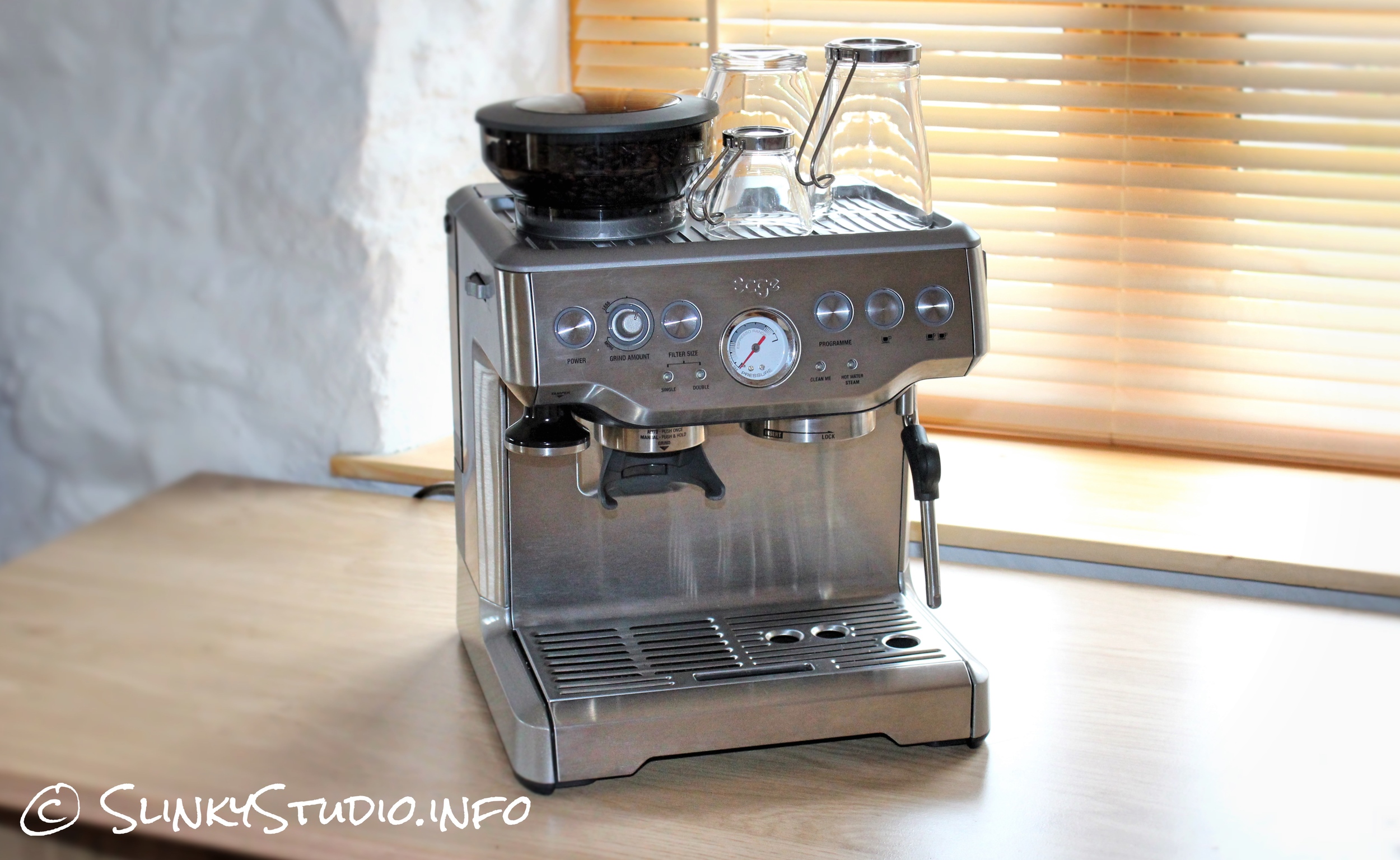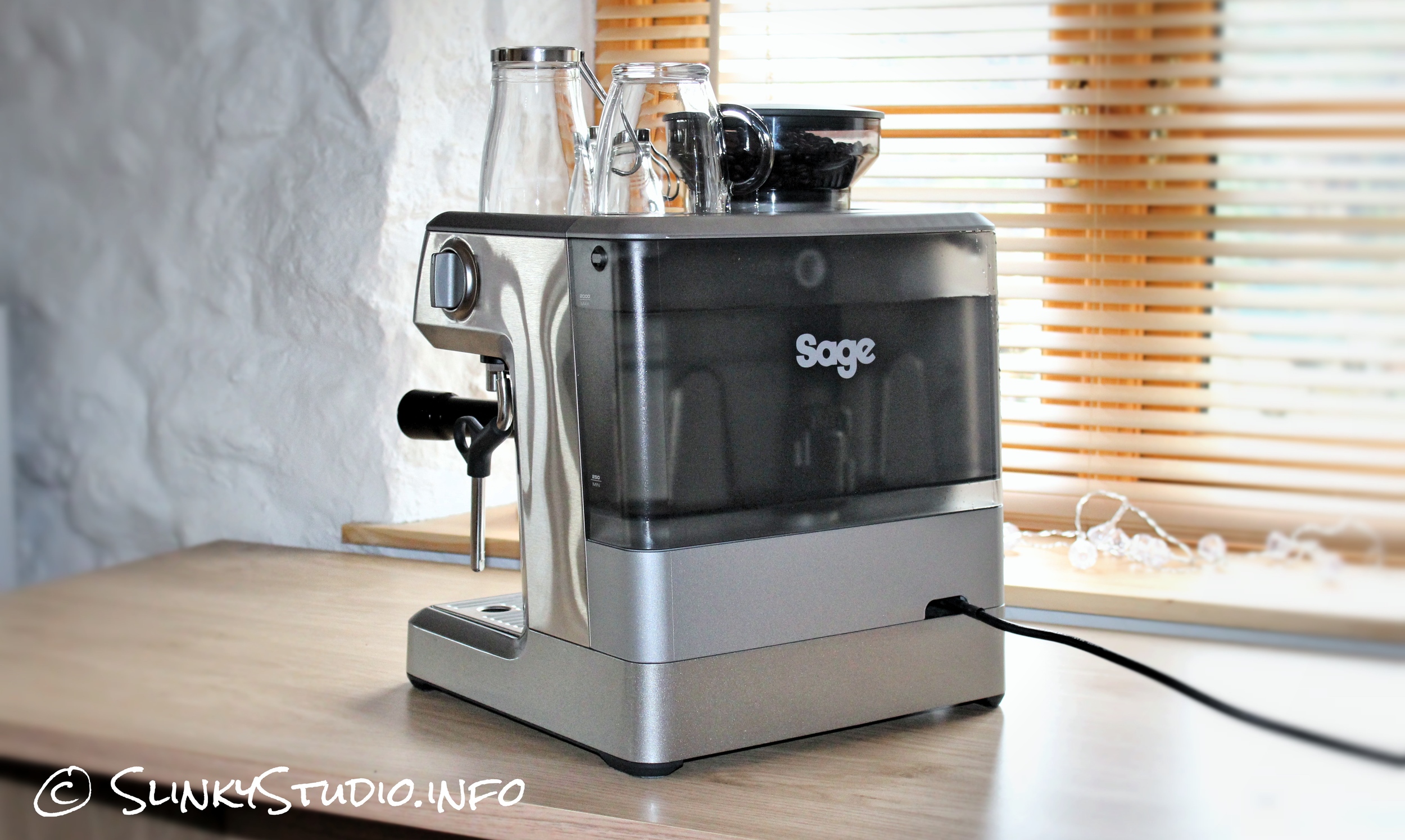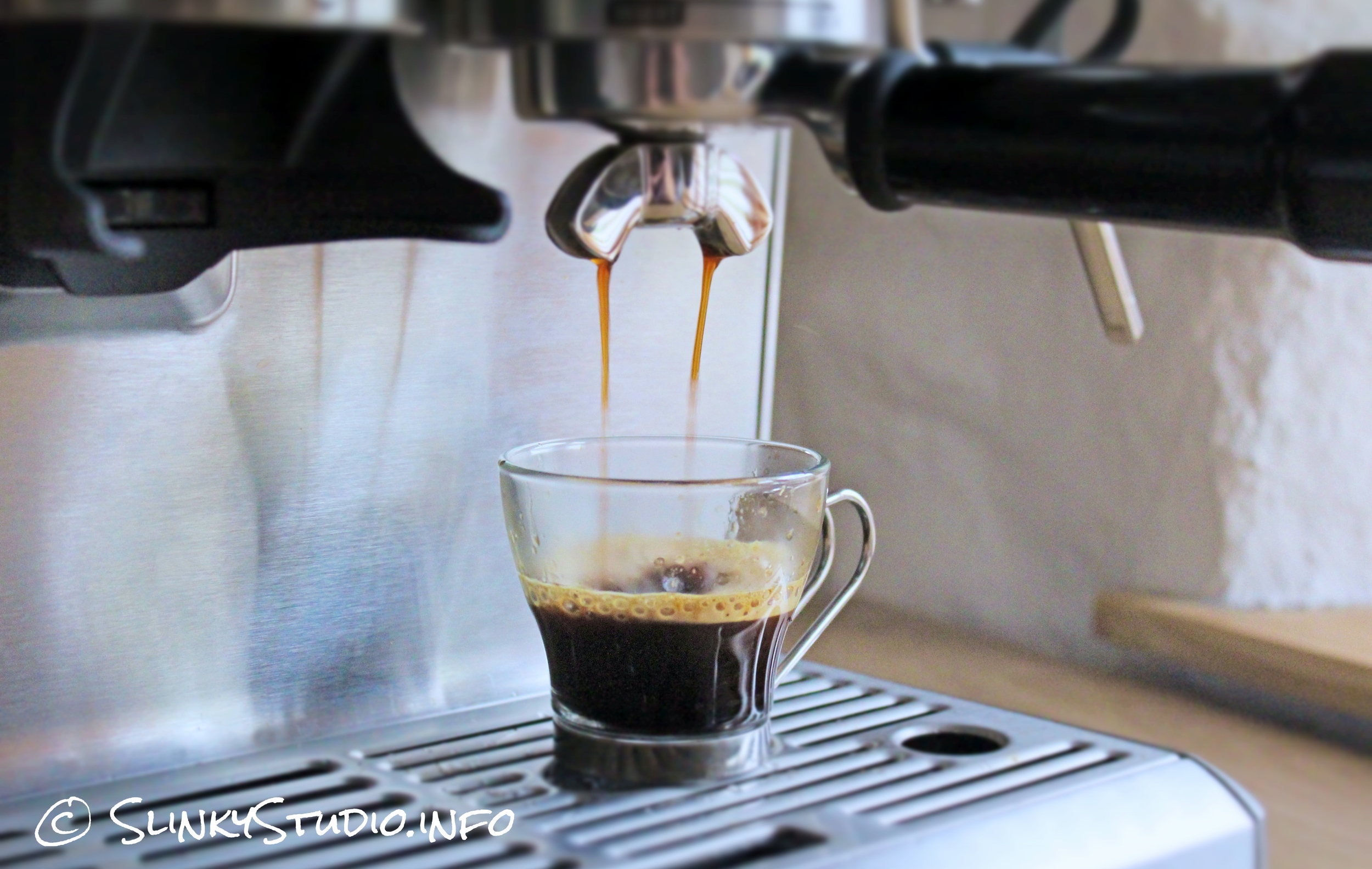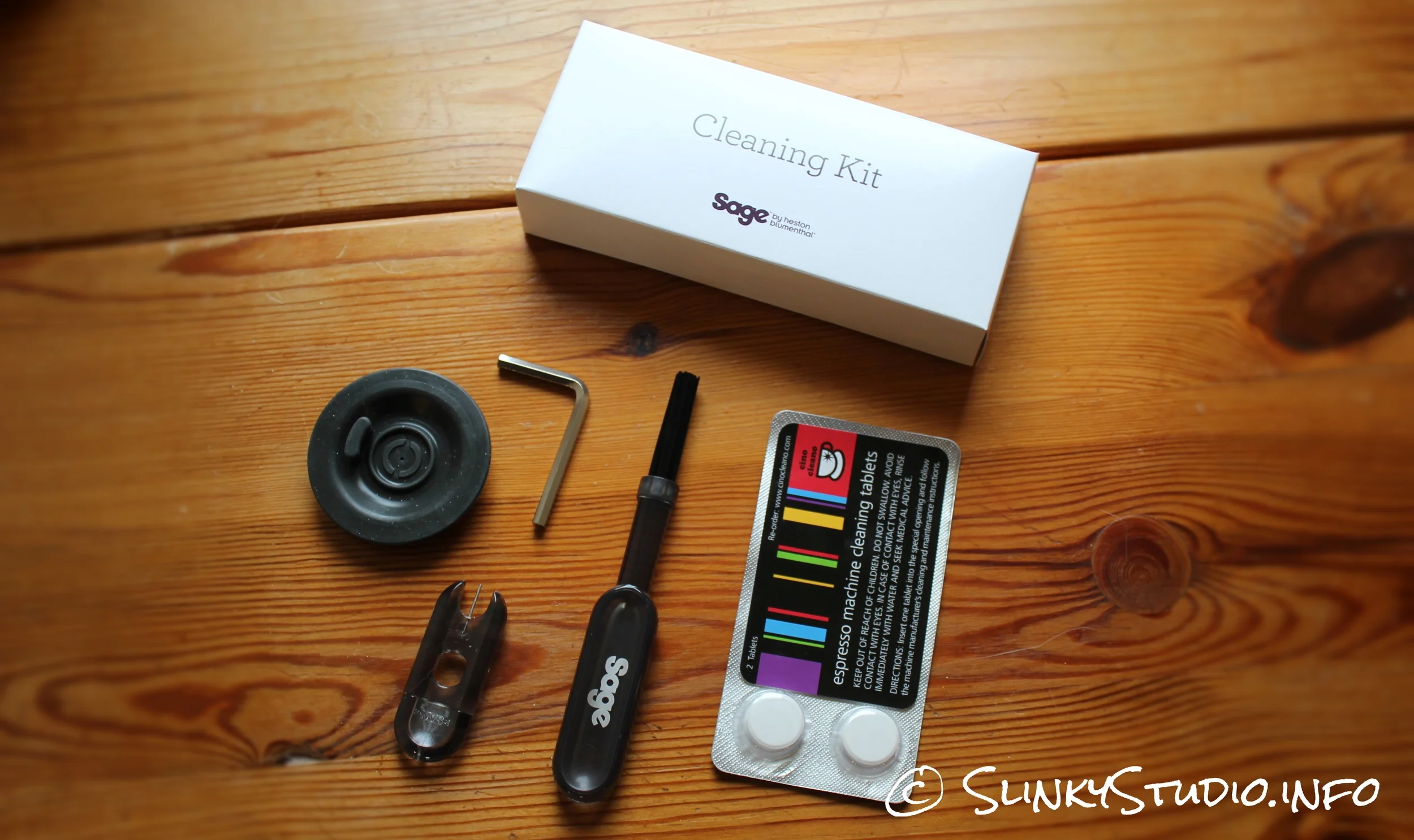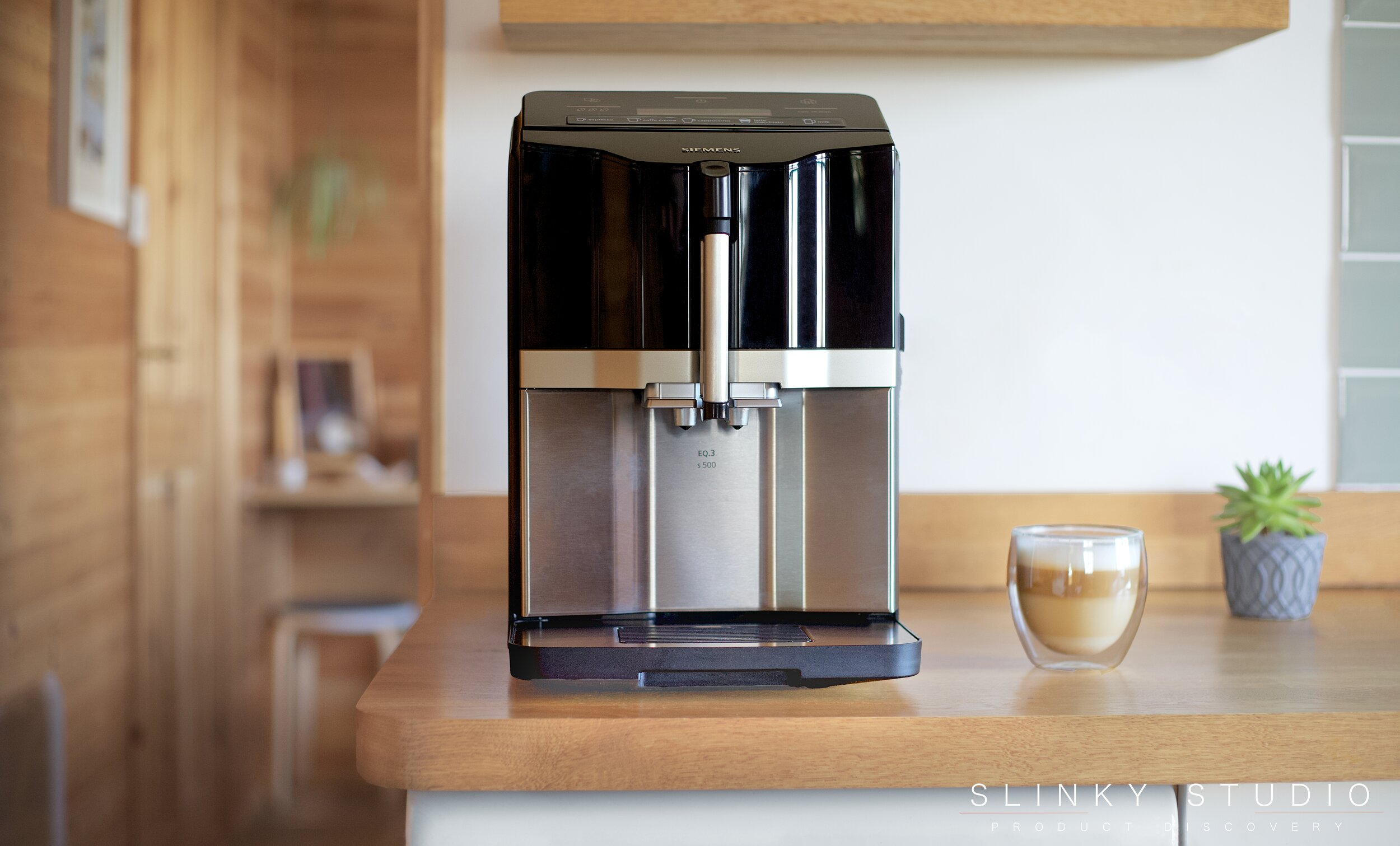Sage Barista Express Review
The public is increasingly enjoying the contrasting world of flavours and aromas that freshly ground coffee and authentic barista hand-crafted beverages bring in great coffee shops, and now it is evident, by the large drop in instant coffee sales and the growth in ground coffee and whole coffee bean sales, that consumers want to take home the quality they have previously been treated to outside their homes. Sage by Heston Blumenthal believe they have a product that accomplishes just that, and the Sage Barista Express (BES870XL) makes it possible to create cappuccinos, lattes, flat whites, macchiatos, etc, within the comfort of our own homes, combining everything you need into one single appliance. The only element missing in the incredibly articulately packaged box is the coffee itself.
Design
A sophisticated image is fabricated from the charming brushed stainless steel exterior. A flurry of buttons, knobs and a centre gauge, are necessary but nicely subtle in their implementation. It’s a user friendly design too, including a tamper tool that should never get misplaced as it magnetically connects under the left side of the Barista Express. Furthermore, around four or five cups can be efficiently stored on top, where the heat from the machines's Thermocoil penetrates and warms them.
Weighing 10kg, with rubber feet fixed on its base, the Sage Barista Express didn’t scurry around when we inserted the 54mm portafilter or removed the drip tray to access the hidden removable compartment tray behind it that retains the filter baskets, razor tool for dosing, and cleaning tools. We really liked the fact that the drip tray attempts, with much success, to separate loose coffee grinds from water (roughly 600ml capacity), and additionally handily alerts us when it’s filing up via a novel ‘empty me’ message that slowly floats up through the grill of the tray. Ordinarily we needed to empty ours every two days from making three americanos and three milk based drinks.
Located on the back of the appliance is a generous 2L water tank that includes a handle for quick and manoeuvrable access for refilling at the tap. It’s a good thing too, as ours needs refilling every 2 days. But unlike many coffee machines we use, this one annoyingly doesn’t warn us when the level of water is low or empty. A simple single LED light to signal this would do the job, as there’s not many things more frustrating than making a shot of espresso and the water running out mid-way through extracting.
Controls
Yes, you wouldn't be wrong in thinking there’s an alarming number of buttons, knobs and LED lights on show. But if you inspect them closely, you’ll notice that nothing is ill thought out. The left portion of controls are all dedicated to the coffee bean grinder and the right portion all operate the extraction of espresso: the left espresso extraction button being a programable one for adjusting things like the size of a single and double espresso, with the other two buttons on the right of this. On the right side of the machine is a knob for selecting between steam mode and hot water dispensing. Generally we felt the control scheme was simple enough to grasp on the first instance of using the Barista Express and that the LED lights that surround each button really lend a helping hand on early dull mornings.
Bean Hopper & Grinder
Integrating a place to store and grind your beans within the machine has obvious benefits, being far more convenient, and you only need to use one electric socket for power. However, more importantly, it refrains you from the temptation to grind all your coffee beans at once and thus losing the oils that hold the flavours. The 250g capacity of the vacuum sealed bean hopper is sufficient for making 25 shots of espresso, and if you decide you want to change the blend of beans, the hopper can be detached from the top of the Sage Barista Express and remaining beans can be easily re-dispensed into a bag via a simple undoing lock, meaning you can easily change over blends of coffee during use if desired.
This conical burr grinder, with stainless steel blades, is easily unlocked for cleaning and has 18 grind settings from coarse to fine, all selectable via a slider wheel on the left side of the appliance. It’s an immensely strong grinder that effortlessly achieves the very finest of grinds. Additionally, the grind quantity, including whether you’re using a single or double shot filter basket, is all selectable via the left button controls. We're fond of the intuitive way the grinder starts by simply pushing on the end of the portafilter. All the ground coffee falls directly into the filter basket, hands-free, ready for tamping.
Espresso Performance
Making espresso is an exact science and there are many fundamental components to the process. Sage captured our attention by claiming anyone can obtain espresso from whole coffee beans in under one minute. Comparatively single serve pod based coffee machines acquire similar speed, but without any of the prep. So we put the Sage Barista Express to the test. The result was that at a normal pace we could grind, tamp and extract the perfect shot of espresso with 10 seconds to spare.
Upon pressing either the single or double shot espresso buttons, the Sage Barista Express will pre-infuse the ground coffee within the portafilter, soaking all the grounds so they expand. Then the machine will quickly elevate the pressure, finalising the extraction. Consequently the centre pressure gauge will show you whether you’ve got the grind, dose and tamp correct. Ideally the needle should be midway within the espresso range of the meter. If it goes too high, the espresso will be inconsistent in flow and we noticed this results in a bitter flavour, and if the meter goes too low, the espresso flows too fast and the shot will lack body and flavour. This visual feedback allowed us to adjust the factors and keep trying for a perfect shot of espresso. Of course, getting all these variables in-line is tricky and we found that with each new fresh variety of coffee beans it took two or three attempts to figure out the right correlation of settings for a smooth flowing, full bodied espresso extraction.
Nevertheless, the 15 bar Italian made pump can dispense unquestionably phenomenal espresso! With fresh whole bean coffee, we always use the single wall (double or single shot) espresso filters, which are supplied in the box along with two dual wall filters. The single walls achieve sensationally flavoursome and creamy espresso and the crema can measure over 2cm. But we also use pre-ground coffee sometimes and this is where the dual wall filters are effective. These literally have just one pin-sized hole in them for the extraction of espresso, and of course, this initiates heavy pressure that delivers a flattering outcome for pre-ground coffee. Crema is apparent and some layering also, but when we compare the espresso from fresh coffee beans, pre-ground coffee is noticeably lifeless. However, the dual wall filters can be helpful for consistency of pressure when starting out with fresh beans too.
Milk Steaming
A one hole steam arm is fixed onto the Sage Barista Express via a ball joint so that it has 360° movement. The reason for this adept manoeuvrability is because there's no assistance or automation here: to achieve the results you want it will all boil down to raw technique. Generally speaking, it took our inexperienced members of the team two weeks to grasp how to feel the milk as it textures and how to get the right steamed milk for the corresponding drink. Furthermore, this steam arm is reasonably punchy in pressure, but does give you time to work the milk, so it won’t overwhelm beginners by splashing the milk out of the supplied 480ml pitcher. When the steam arm is finished with, the Sage Barista Express will kindly purge the machine automatically from the higher heat levels needed for steaming, bringing the temperature back down for making espresso.
We’ve made hot chocolates, lattes, macchiatos, cappuccinos and flat whites using the Sage Barista Express. The results have all been delectable and the steam wand never fails us in pressure. It takes around 40-50 seconds to reach the level of micro foam and texture for something like a cappuccino. When you master the art of steaming milk with a single hole steam arm, you’ll realise that this feature is competently up to the challenge. It can grasp creamy texture with a little wet foam for flat whites or lattes, or creaminess with lots of dry foam for cappuccinos. Consequently this amount of bespoke choice will empower people to find the levels of texture and foam they want.
Clean Up & Maintenance
As already noted, the blades within the burr bean grinder, the bean hopper and drip tray are all easily removable for cleaning, but the thing to clean after every use is the portafilter. A feature we adored was that a valve will rid the portafilter of excess water, so the used coffee comes out compacted and it only takes a matter of seconds to clean the few remaining grounds out with water. A cleaning kit is included, with a tool to clean the end of the steam arm if it gets bunged up with milk and to un-lodge coffee grind within the filter baskets. There is also a brush tool to clean the shower head (also removable via a supplied allen key).
Occasionally the Barista Express will alert you that it needs a thorough 5 minute automated cleaning session by illumining an LED on the front. In this eventuality a supplied rubber filter needs to be inserted into the single wall basket within the portafilter, along with a cleaning tablet (two supplied in the box) to flush the machine. Also worth noting is that if you’re living in a hard water area, the filter within the water tank needs to be changed every two months to prevent lime scale build up within the machine.
Thermocoil Heating & Temperature Adjustment
The 1850W Sage Barista Express uses Thermocoil, a coiled heating element cased in solid aluminium. Cold water flows within a stainless steel tube through the aluminium, which results in hot water being created. The temperature of the water from the hot water spout and through the portafilter didn’t fluctuate by more than a few degrees fahrenheit in our tests. However, the very first helping of water dispensed when purging the machine upon startup is cooler. Also worth noting is that the user can reprogram the temperature to increase or decrease by a factor of 4°F from the factory default of 200°F, all because of an inbuilt PID digital temperature controller. This Thermocoil system is speedy, with the Sage Barista Express only taking 35 seconds to heat up from turing on. Unfortunately, because it doesn’t have dual boilers, you can’t extract espresso at the same time as steaming milk, but then another boiler would no doubt add to the price.
Overall
Sage by Heston Blumenthal have created a friendly and feature rich appliance that challenges the user and gives them all the feedback and capacity to create the perfect espresso every time. Everyone at the studio, after using the Barista Express for almost two months, can extract incredibly flavoursome and full bodied espressos. The inbuilt steam arm, bean hopper and burr coffee bean grinder additionally cement this product as a friendly out of the box all-in-one ready solution for all espresso based drinks.


